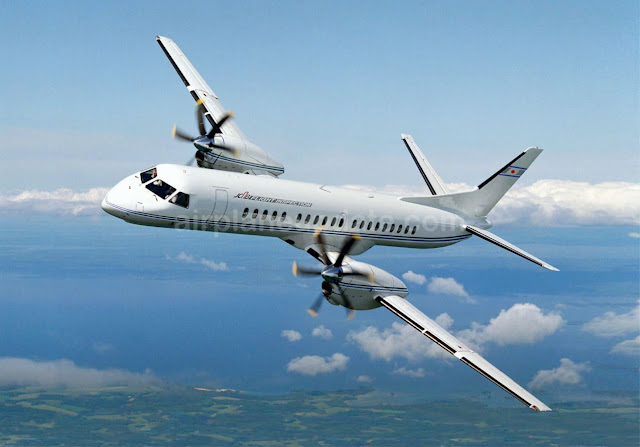Saab 2000 Specs, Interior, Cockpit, and Price – Saab 2000 is a regional turboprop engine developed by Saab Aircraft, Sweden. The Saab 2000 aircraft made its first flight in March 1992 and entered service with the launch customer Crossair (now Switzerland) in 1994. The Saab 2000 aircraft is an extended version of the Saab 340.
The Saab 2000 aircraft is being developed as an early warning and air control variant (AEWC). This variant is equipped with Saab Systems Erieye PS-890 which sided with the spine which looked like a surveillance radar. Another variant is the Saab 2000FI, a flight inspection mission aircraft developed for the Japanese Civil Aviation Bureau.

The Saab 2000 aircraft has two integral fuel tanks mounted on the wing. The tank can hold fuel with a total capacity of 5,300 l. The fuel system is equipped with a gravity overwing refueling station on each wing and one pressure refueling station on the right wing.
Saab 2000 aircraft can fly with a maximum cruise speed of 685 km / h and have a maximum range of 2,868 km. High speed performance allows airline operators to exchange fleet schedules with jets on 500 nm routes. The aircraft can carry 50 passengers to destinations of more than 1,000 nm in three hours flight time.


The Saab 2000 navigation suite includes an inertia reference system, Rockwell Collins WR-840 solid-state weather radar with an optional turbulence detection radar. The cockpit has Swedlow panel windshield which is electrically heated.
Saab Aircraft, headquartered in Washington DC, leases around 289 Saab 340 and Saab 2000 aircraft to 25 airlines. Airlines that rented Saab 2000 included AirJet of France, Lithuanian Airlines, AeroLitoral of Mexico, Transwest Air of Canada, Blue 1 (formerly Air Botnia) from Finland and OLT GmbH from Germany.
The Saab 2000 aircraft is being developed as an early warning and air control variant (AEWC). This variant is equipped with Saab Systems Erieye PS-890 which sided with the spine which looked like a surveillance radar. Another variant is the Saab 2000FI, a flight inspection mission aircraft developed for the Japanese Civil Aviation Bureau.

Saab 2000 Specs
The design of the Saab 2000 airframe is based on the Saab 340. The aircraft is integrated with low wings and a conventional tail. The aircraft propulsion system is a six-bladed type Dowty R381 propeller system. The propeller is equipped with electric de-icing. Overall, Saab 2000 has a length of 27.28 m, a fuselage diameter of 2.31 m, a height of 7.73 m, and a wingspan of 24.76 m.The Saab 2000 aircraft has two integral fuel tanks mounted on the wing. The tank can hold fuel with a total capacity of 5,300 l. The fuel system is equipped with a gravity overwing refueling station on each wing and one pressure refueling station on the right wing.
Saab 2000 Engine and Performance
The Saab 2000 aircraft are powered by two Rolls-Royce Allison AE 2100A turboprop engines. Each engine is capable of producing a maximum power of 3,096 kW and is equipped with Lucas Aerospace Full Authority Digital Engine Control (FADEC). The aircraft is equipped with an additional Sundstrand power unit providing power for engine start and for the air conditioning system.Saab 2000 aircraft can fly with a maximum cruise speed of 685 km / h and have a maximum range of 2,868 km. High speed performance allows airline operators to exchange fleet schedules with jets on 500 nm routes. The aircraft can carry 50 passengers to destinations of more than 1,000 nm in three hours flight time.

Saab 2000 Cabin and Interior
The Saab 2000 cabin is 16.7 m long and 2.16 m wide. The cabin is configured in one aisle with three-parallel seating arrangements to accommodate 50 to 58 passengers. The cabin is equipped with an active Ultra Electronics noise control system. The aircraft is equipped with a Pacific Scientific fire detection system, a Kidde Graviner fire extinguisher system, AC Hamilton Standard Recircair and an environmental control system that uses air from the engine. The pressurized and air-conditioned cabin will make passengers feel comfortable when on the plane.
Saab 2000 Cockpit and Avionics
The Saab 2000 cockpit is equipped with the Rockwell Collins Pro Line 4 avionics suite with an integrated avionics processor (IAP), engine indication and crew warning system (EICAS) and traffic warning systems and impact avoidance systems (TCAS). Flight control systems include the Post and Attitude Reference System (AHRS) and the Digital Air Data System (DADS).The Saab 2000 navigation suite includes an inertia reference system, Rockwell Collins WR-840 solid-state weather radar with an optional turbulence detection radar. The cockpit has Swedlow panel windshield which is electrically heated.
Saab 2000 Price and Orders
The price of the Saab 2000 aircraft is around US $ 15 million. There are 60 Saab 2000 aircraft operating throughout the world in France, Ireland, Italy, Japan, Lithuania, Marshall Islands, Sweden, Switzerland and the United States. However, aircraft production had stopped in 1999.Saab Aircraft, headquartered in Washington DC, leases around 289 Saab 340 and Saab 2000 aircraft to 25 airlines. Airlines that rented Saab 2000 included AirJet of France, Lithuanian Airlines, AeroLitoral of Mexico, Transwest Air of Canada, Blue 1 (formerly Air Botnia) from Finland and OLT GmbH from Germany.








No comments:
Post a Comment